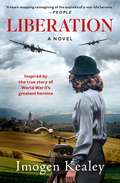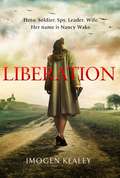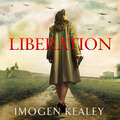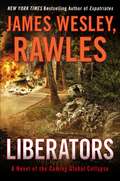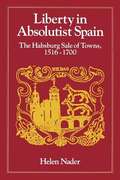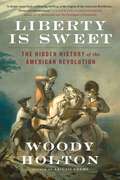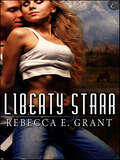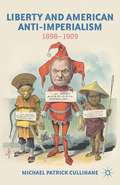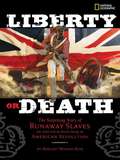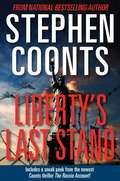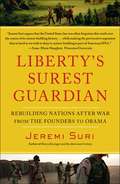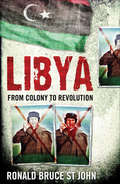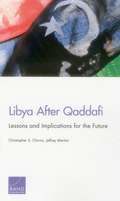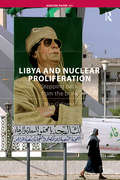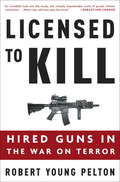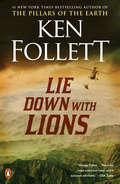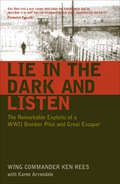- Table View
- List View
Liberation: Inspired By The Incredible True Story Of World War Ii's Greatest Heroine Nancy Wake
by Imogen KealeyHero. Soldier. Spy. Leader. Her name is Nancy Wake. The international bestseller -- a "thrilling debut" and "cinematic treat" -- inspired by the true story of World War II's greatest heroine (Publishers Weekly). p.p1 {margin: 0.0px 0.0px 0.0px 0.0px; font: 12.0px 'Times New Roman'} To the Allies, she was a fearless freedom fighter, a special operations legend, a woman ahead of her time. To the Gestapo, she was a ghost, a shadow, the most wanted person in the world. But at first, Nancy Wake was just another young woman living in Marseilles and recently engaged to a man she loved. Then France fell to the Nazi blitzkrieg. With her appetite for danger, Nancy quickly finds herself drawn into the underground Resistance standing up to Nazi rule. Gaining notoriety as the White Mouse, with a 5-million-franc bounty hanging over her head, Wake rises to the top of the Nazi's Most Wanted list -- only to find her husband arrested for treasonous activity under suspicion of being the White Mouse himself. Narrowly escaping to Britain, Wake joins the Special Operations Executive (SOE) and parachutes into the Auvergne, where she must fight for the respect of some of the toughest Resistance fighters in France. As she and her maquisards battle the Nazis, their every engagement brings the end of the war closer -- but also places her husband in deeper peril. A riveting, richly imagined historical thriller, LIBERATION brings to life one of World War II's most fascinating unsung heroines in all her fierce power and complexity. This is the story of one of the one of the war's most decorated women, told like never before.
Liberation: Inspired by the incredible true story of World War II's greatest heroine Nancy Wake
by Imogen KealeyInspired by the incredible true story of the most decorated servicewoman of the second world war. Nancy Wake was an Australian girl who, aged, 16 ran away from her abusive mother to the other side of the world.Nancy Wake was a wife who, when her husband was snatched by the Gestapo, fought to be trained by SOE and returned to France to take her revenge.Nancy Wake was a soldier who led a battalion of 7,000 French Resistance fighters who called her Field Marshall. Who had a 5-million Franc bounty on her head. Who killed a Nazi with her bare hands. Who defeated 22,000 Germans with the loss of only 100 men. Who sold her medals because, "I'll probably go to hell and they'd melt anyway."Discover the roots of her legend in a thriller about one woman's incredible quest to turn the tide of the war, save the man she loves and take revenge on those who have wronged her.
Liberation: Inspired by the incredible true story of World War II's greatest heroine Nancy Wake
by Imogen KealeyThe must-read thriller inspired by the true story of Nancy Wake, whose husband was kidnapped by the Nazis and became the most decorated servicewoman of the Second World War - soon to be a major blockbuster film.To the Allies she was a fearless freedom fighter, special operations super spy, a woman ahead of her time. To the Gestapo she was a ghost, a shadow, the most wanted person in the world with a five-million-Franc bounty on her head. Her name was Nancy Wake.Now, for the first time, the roots of her legend are told in a thriller about one woman's incredible quest to turn the tide of the war, save the man she loves and take brutal revenge on those who have wronged her.
Liberators
by Rawles James WesleyThe latest survivalist thriller from the New York Times bestselling author and founder of survivalblog.com gives readers an unprecedented look into a post-apocalyptic world resulting from an all-too-real disaster scenario. When looting and rioting overwhelm all the major US cities, Afghanistan War vet Ray McGregor makes his way from Michigan's Upper Peninsula to his parents' cattle ranch in Bella Coola, British Columbia, in remote western Canada. Joining him is his old friend Phil Adams, a Defense Intelligence Agency counterintelligence case officer based in Washington State. Reckless banking practices, hyperinflation, and government negligence have led to an unprecedented socioeconomic collapse in America that quickly spreads throughout the world. Lightly populated Bella Coola is spared the worst of the chaos, but when order is restored it comes in the form of a tyrannical army of occupation. Ray and Phil soon become key players in the resistance movement, fighting the occupiers in a war that will determine not only their own personal survival, but also the future of North America. Liberators depicts a world that is all too conceivable and terrifyingly familiar. Fastpaced and packed with authentic information on outdoor survival, self-sufficiency, and small-unit tactics, James Wesley, Rawles's latest thriller will resonate with his dedicated fanbase and encourage new readers to prepare for anything from lesser disasters to the dreaded worst-case scenario.
Liberators
by Rawles James WesleyThe New York Times bestselling author of Patriots and How to Survive the End of the World as We Know It returns with another riveting postapocalyptic tale New York Times bestselling author James Wesley, Rawles has won a large readership among the growing ranks of survivalists and preppers with novels that combine fast-paced adventure with useful how-to information. Set against a backdrop of global socioeconomic collapse, Liberators features Afghanistan War vet Ray McGregor and Phil Adams, a Defense Intelligence Agency officer. When the United States is engulfed by chaos, a tyrannical army of occupation ruthlessly restores order. Operating out of a sparsely populated town in remote western Canada, the two men fight the occupiers to ensure not only their own survival, but also the future of North America.ance movement, fighting the occupiers in a war that will determine not only their own personal survival, but also the future of North America. Liberators depicts a world that is all too conceivable and terrifyingly familiar. Fastpaced and packed with authentic information on outdoor survival, self-sufficiency, and small-unit tactics, James Wesley, Rawles's latest thriller will resonate with his dedicated fanbase and encourage new readers to prepare for anything from lesser disasters to the dreaded worst-case scenario.
Liberty (Dogs of World War II)
by Kirby LarsonFrom a Newbery Honor author, a white boy and black girl bond in World War II Louisiana as they rescue a dog in this “practically perfect” historical novel (Kirkus Reviews).With his dad serving in World War II in Europe, and his sister working at the Higgins Boat factory to support the war effort, Fish Elliot fights off loneliness. That is, when he’s not fending off his annoying neighbor, Olympia, who has a knack for messing up Fish’s inventions. But when his latest invention leads Fish to Liberty, a beautiful stray dog who needs a home, he and Olympia work together to rescue her. His growing friendship with Olympia, who is African American, is not the norm in 1940s New Orleans. But as they work together to save Liberty, he finds his perceptions of the world—of race and war, family and friendship—transformed.“Larson . . . creates an engaging story that is rich in historical details. She purposefully captures both the fear and the hope in a world torn by war as well as the simple love of a boy for his dog. Practically perfect.” —Kirkus Reviews“A slice-of-life tale for historical fiction fans and animal lovers alike.” —School Library Journal
Liberty In Absolutist Spain: The Habsburg Sale Of Towns, 1516-1700
by Helen NaderThroughout early modern Europe, one of the most extraordinary royal fund-raising schemes was the seizure and sale of church property to finance foreign wars. The monarchs of Habsburg Spain extended these seizures to municipal property and used the revenue to maintain their empire. They sold charters of autonomy to hundreds of villages, thus converting them into towns, and sold towns to private buyers, thus increasing the number of seigniorial lords. In Hapsburg Spain, therefore, absolutism did not mean centralization. Rather, the kings invoked their absolute power to decentralize authority and allow their subjects a surprising degree of autonomy.
Liberty Is Sweet: The Hidden History of the American Revolution
by Woody HoltonA sweeping reassessment of the American Revolution, showing how the Founders were influenced by overlooked Americans—women, Native Americans, African Americans, and religious dissenters. Using more than a thousand eyewitness accounts, Liberty Is Sweet explores countless connections between the Patriots of 1776 and other Americans whose passion for freedom often brought them into conflict with the Founding Fathers. &“It is all one story,&” prizewinning historian Woody Holton writes. Holton describes the origins and crucial battles of the Revolution from Lexington and Concord to the British surrender at Yorktown, always focusing on marginalized Americans—enslaved Africans and African Americans, Native Americans, women, and dissenters—and on overlooked factors such as weather, North America&’s unique geography, chance, misperception, attempts to manipulate public opinion, and (most of all) disease. Thousands of enslaved Americans exploited the chaos of war to obtain their own freedom, while others were given away as enlistment bounties to whites. Women provided material support for the troops, sewing clothes for soldiers and in some cases taking part in the fighting. Both sides courted native people and mimicked their tactics. Liberty Is Sweet gives us our most complete account of the American Revolution, from its origins on the frontiers and in the Atlantic ports to the creation of the Constitution. Offering surprises at every turn—for example, Holton makes a convincing case that Britain never had a chance of winning the war—this majestic history revivifies a story we thought we already knew.
Liberty Starr
by Rebecca E. GrantRafe had never met a truly irresistible woman, until he met Liberty.Libby has the kind of beauty that comes on slow-strikes a guy the longer he looks. And Rafe sure is having a fine time looking, and touching, and loving Liberty Starr.The only problem is that Rafe is pretending to be just another cowboy down on his luck. Working for the FBI, he's come to Stone Hill, Colorado, to investigate the man Libby loves like a father.He was just another cowboy.Free-spirited Libby offers him a job and a place to stay. Together they spark like wildfire, their intense passion filling their days and nights. But Rafe is only in town for the summer, and while Liberty is willing to risk her heart, secrets threaten any possibility of a future together...77,000 words
Liberty and American Anti-Imperialism: 1898-1909
by Michael Patrick CullinaneThis book provides a study of the American anti-imperialist movement during its most active years of opposition to US foreign policy, from 1898 to 1909. It re-evaluates the movement's motives and operations throughout these years by evaluating the way in which Americans conceived the idea of 'liberty. '
Liberty or Death: The Surprising Story of Runaway Slaves Who Sided with the British During the American Revolution
by Margaret Whitman BlairLiberty or Death is the little-known story of the American Revolution told from the perspectives of the African-American slaves who fought on the side of the British Royal Army in exchange for a promise of freedom. Motivated by the 1775 proclamation by Virginia’s Royal Governor that any slaves who took up arms on his behalf would be granted their freedom, these men fought bravely for a losing cause. Many of the volunteers succumbed to battle wounds or smallpox, which ran rampant on the British ships on which they were quartered. After the successful Revolution, they emigrated to Canada and, ultimately to West Africa. Liberty or Death is the inspiring story of the forgotten freedom fighters of America’s Revolutionary War.
Liberty's Last Stand (Tommy Carmellini Ser. #7)
by Stephen CoontsNew York Times bestselling author Stephen Coonts delivers another nail-biting thriller starring CIA Director Jake Grafton and his right-hand man, Tommy Carmellini. The president of the United States stands on an outdoor stage, flanked by powerful members of his administration and party. Television crews are preparing for broadcast. High above the stage, on a nearby rooftop, a decorated sniper adjusts the scope on his rifle.Afterwards, America will never be the same.Jake Grafton and Tommy Carmellini suddenly find themselves on the wrong side of the law when a public act of violence throws the country into chaos just before a presidential election. After martial law is declared and rioting begins, Grafton and Carmellini must risk everything to unravel a massive conspiracy and help a new resistance movement rise up against an unimaginable enemy...
Liberty's Provenance: The Evolution of the Liberty Ship from Its Sunderland Origins
by John Henshaw&“Deserves consideration from anyone interested in how the ship design process is translated into actual product which in turn can win a war.&” —Warship International The Battle of the Atlantic, fought by the Allies to maintain lines of communication and vital trade routes for armaments, men, and basic sustenance, could not have been won without the 2,710 Liberty ships that were designed and built for those critical one-way voyages to Europe—more than one voyage was considered a bonus. The kudos for the Liberty&’s construction rightfully belongs to America, but few people know that the groundwork for the shape of the hull and its basic hydrodynamics took place in the North Sands shipyard of Joseph Thompson & Sons Ltd on the banks on the River Wear in Sunderland, England. This new book follows the path of the critical designs that flowed from Thompson&’s shipyard, commencing with SS Embassage in 1935, to SS Dorington Court in 1939, through the SS Empire Wind/Wave series for the Ministry of War Transport in 1940 to SS Empire Liberty in 1941. These led to the sixty Ocean Class vessels built by Henry J. Kaiser and, from these, the Liberty ship was adapted by American naval architects Gibbs & Cox who, to this very day, still claim they designed the Liberty ship. With the use of beautifully drawn ship profiles, starting with World War I designs, then the critical designs from Thompson&’s shipyard, and particularly a drawing comparing the Liberty ship with its British progenitor, the author demonstrates just how much of the former was borrowed from the latter. While some credit has been given to Thompson&’s designs, this new book offers the first real proof as to the direct link between his work, the Empire Liberty/Ocean Class, and the Liberty ship that followed. In addition, the book demonstrates the versatility of the Liberty ship and explores those that were developed for specialist use, from hospital ships and mule transports to nuclear-age missile range ships.
Liberty's Surest Guardian
by Jeremi SuriAmericans are a nation-building people, and in Liberty's Surest Guardian, Jeremi Suri--Nobel Fellow and leading light in the next generation of policy makers--looks to America's history to see both what it has to offer failed states around the world and what it should avoid. Far from being cold imperialists, Americans have earnestly attempted to export their invention of representative government. We have had successes (Reconstruction after the American Civil War, the Philippines, Western Europe) and failures (Vietnam), and we can learn a good deal from both. Nation-building is in America's DNA. It dates back to the days of the American Revolution, when the founding fathers invented the concept of popular sovereignty--the idea that you cannot have a national government without a collective will. The framers of the Constitution initiated a policy of cautious nation-building, hoping not to conquer other countries, but to build a world of stable, self-governed societies that would support America's way of life. Yetno other country has created more problems for itself and for others by intervening in distant lands and pursuing impractical changes. Nation-building can work only when local citizens "own it," and do not feel it is forced upon them. There is no one way to spread this idea successfully, but Suri has mined more than two hundred years of American policy in order to explain the five "P"s of nation-building: PARTNERS: Nation-building always requires partners; there must be communication between people on the ground and people in distant government offices. PROCESS: Human societies do not follow formulas. Nation-building is a process which does not produce clear, quick results. PROBLEM-SOLVING: Leadership must start small, addressing basic problems. Public trust during a period of occupation emerges from the fulfillment of basic needs. PURPOSE: Small beginnings must serve larger purposes. Citizens must see the value in what they're doing. PEOPLE: Nation-building is about people. Large forces do not move history. People move history. Our actions in Iraq, Afghanistan, and Libya will have a dramatic impact on international stability. Jeremi Suri, provocative historian and one of Smithsonian magazine's "Top Young Innovators," takes on the idea of American exceptionalism and turns it into a playbook for President Obama over the next, vital few years.
Liberty's Surest Guardian: American Nation-Building from the Founders to Obama
by Jeremi SuriAmericans are a nation-building people, and in Liberty's Surest Guardian, Jeremi Suri--Nobel Fellow and leading light in the next generation of policy makers--looks to America's history to see both what it has to offer failed states around the world and what it should avoid. Far from being cold imperialists, Americans have earnestly attempted to export their invention of representative government. We have had successes (Reconstruction after the American Civil War, the Philippines, Western Europe) and failures (Vietnam), and we can learn a good deal from both. Nation-building is in America's DNA. It dates back to the days of the American Revolution, when the founding fathers invented the concept of popular sovereignty--the idea that you cannot have a national government without a collective will. The framers of the Constitution initiated a policy of cautious nation-building, hoping not to conquer other countries, but to build a world of stable, self-governed societies that would support America's way of life. Yetno other country has created more problems for itself and for others by intervening in distant lands and pursuing impractical changes. Nation-building can work only when local citizens "own it," and do not feel it is forced upon them. There is no one way to spread this idea successfully, but Suri has mined more than two hundred years of American policy in order to explain the five "P"s of nation-building: PARTNERS: Nation-building always requires partners; there must be communication between people on the ground and people in distant government offices. PROCESS: Human societies do not follow formulas. Nation-building is a process which does not produce clear, quick results. PROBLEM-SOLVING: Leadership must start small, addressing basic problems. Public trust during a period of occupation emerges from the fulfillment of basic needs. PURPOSE: Small beginnings must serve larger purposes. Citizens must see the value in what they're doing. PEOPLE: Nation-building is about people. Large forces do not move history. People move history. Our actions in Iraq, Afghanistan, and Libya will have a dramatic impact on international stability. Jeremi Suri, provocative historian and one of Smithsonian magazine's "Top Young Innovators," takes on the idea of American exceptionalism and turns it into a playbook for President Obama over the next, vital few years.
Libya
by Ronald Bruce St. JohnCombining a historian's balance with an analyst's insight to skilfully navigate Libya's eventful past and present, Ronald Bruce St John updates his authoritative history of this turbulent North African state to include an in-depth examination of the 2011 rebellion that finally put an end to over 40 years of authoritarian rule by Qadaffi. From early Greek settlements to the infamous Lockerbie bombing, and from the colonel's astonishing return to the international stage to the events that led to his ousting, this stands as an essential introduction to this complex land on the cusp of Africa and the Middle East. Ronald Bruce St John is a scholar of Libya, having consulted to ABC's 20/20, the New York Times, Fortune 500 companies, and the U.S. government. Now an analyst for the progressive think tank Institute for Policy Studies, he has also served on the advisory board of The Journal of Libyan Studies and the Atlantic Council's working group on Libya. A former military intelligence officer in the US army, he is the author of Libya and the United States and Qaddafi's World Design, among other books.
Libya After Qaddafi: Lessons and Implications for the Future
by Christopher S. Chivvis Jeffrey MartiniThe 2011 overthrow of Libyan dictator Muammar Qaddafi by internationally backed rebel groups has left Libya's new leaders with a number of post-conflict challenges, including establishing security, building political and administrative institutions, and restarting the economy. This report assesses these challenges, the impact of the limited international role in efforts to overcome them, and possible future roles for the international community.
Libya and Nuclear Proliferation: Stepping Back from the Brink (Adelphi Ser. #380)
by Wyn Q. BowenThis Adelphi Paper examines the motives behind Libya‘s pursuit of a nuclear weapons capability, from Gadhafi‘s rise to power in 1969 through to the end of 2003. It also assesses the proliferation pathways that the regime followed during this period, including early dependence on Soviet technology and assistance, subsequently relying on technological infusions from the A.Q. Khan network. Wyn Q. Bowen clearly analyzes the decision to give up the quest for nuclear weapons, focusing on the main factors that influenced the Gadhafi regime‘s calculations, including the perceived need to re-engage, both politically and economically, with the international community, particularly the United States. It explores the process of dismantling the nuclear programme and the question of whether Libya constitutes amodel for addressing the challenges posed by other proliferators.
Licensed to Kill: Hired Guns in the War on Terror
by Robert Young PeltonWhile it is not an entirely new phenomenon, a distinctive feature of the wars in Afghanistan and Iraq have been the number of military "private contractors" that have been employed by the Pentagon in order to carry out traditional military tasks such as protecting infrastructure and individuals. Investigative journalist Pelton offers a partial window into the world of the private contractor that focuses primarily on the men who carry the guns and there experiences in carrying out their duties. He tells the tales of the contractors that died in Fallujah in an event that set the stage for the later US assault on that Iraqi city, his own former bodyguard now serving time for involvement in an attempted coup in Equatorial Guinea, and the man accused of maintaining his own private prison in Afghanistan (who claims that he was acting on behalf of the Central Intelligence Agency), among other guns-for-hire in the "War on Terror. " Annotation ©2007 Book News, Inc. , Portland, OR (booknews. com)
Licensed to Kill: Privatizing the War on Terror
by Robert Young PeltonRobert Young Pelton first became aware of the phenomenon of hired guns in the War on Terror when he met a covert team of contractors on the Afghanistan/Pakistan border in the fall of 2003. Pelton soon embarked on a globe-spanning odyssey to penetrate and understand this shadowy world, ultimately delivering stunning insights into the way private soldiers are used.Enter a blood-soaked world of South African mercenaries and tribal fighters backed by ruthless financiers. Drop into Baghdad’s Green Zone, strap on body armor, and take a daily high-speed ride with a doomed crew of security contractors who dodge car bombs and snipers just to get their charges to the airport. Share a drink in a chic hotel bar with wealthy owners of private armies who debate the best way to stay alive in war zones.Licensed to Kill spans four continents and three years, taking us inside the CIA’s dirty wars; the brutal contractor murders in Fallujah and the Alamo-like sieges in Najaf and Al Kut; the Deep South contractor training camps where ex–Special Operations soldiers and even small town cops learn the ropes; the contractor conventions where macho attendees swap bullet-punctuated tales and discuss upcoming gigs; and the grim Central African prison where contractors turned failed mercenaries pay a steep price.The United States has encouraged the use of the private sector in all facets of the War on Terror, placing contractors outside the bounds of functional legal constraints. With the shocking clarity that can come only from firsthand observation, Licensed to Kill painstakingly deconstructs the most controversial events and introduces the pivotal players. Most disturbingly, it shows that there are indeed thousands of contractors—with hundreds more being produced every month—who’ve been given a license to kill, their services available to the highest bidder.From the Hardcover edition.
Licensed to Marry (Montana Confidential)
by Charlotte DouglasBy day these agents are cowboys; by night they are specialized government operatives. Men bound by love, loyalty and the law-they've vowed to keep their missions and identities confidential...THE MISSION: UNDERCOVER HUSBANDNo woman had ever looked more beautiful to Kyle Foster than the trembling female he rescued from the wreckage of an explosion. But he never dreamed he'd marry Laura Quinlan just days later! When traces of the bomb led to a security leak inside Laura's top-secret laboratory, a stricken Laura made Kyle a shocking proposal-marry her, and infiltrate the lab to find the traitor. As a Confidential agent and single father, Kyle would do anything to make the world a safer place. But living with Laura could prove a deadly distraction. Kyle's daughter loved her. Kyle's own heart was in jeopardy. And now the enemy knew it...
Lie Catcher: Become a Human Lie Detector in Under 60 Minutes
by Dr. David CraigInternational undercover expert and criminologist Dr David Craig gives us an easy-to-read, light-hearted guide that demonstrates through practical examples how to apply lie detecting skills in our day-to-day lives. From bargaining, making a purchase, negotiating a business contract, dealing with children to identifying infidelity, he delivers simple but effective tips and techniques we can all use to see behind the facade and get to the truth.
Lie Down with Lions
by Ken FollettEllis, the American. Jean-Pierre, the Frenchman. They were two men on opposite sides of the cold war, with a woman torn between them. Together, they formed a triangle of passion and deception, racing from terrorist bombs in Paris to the violence and intrigue of Afghanistan--to the moment of truth and deadly decision for all of them...
Lie in the Dark and Listen: The Remarkable Expliots of a WWII Bomber Pilot and Great Escaper
by Ken Rees Karen ArrandaleA memoir of a World War II British bomber pilot who was imprisoned by the Nazis and went on to inspire the Steve McQueen character in The Great Escape. By age 21, Ken had already trained to be a pilot officer, flown 56 hair-raising bomber missions by night over Germany, taken part in the siege of Malta, got married, been shot down into a remote Norwegian lake, been captured and interrogated, sent to Stalag Luft III, and survived the Great Escape and the forced March to Bremen. This is truly a real-life adventure story, written with accuracy, pace, and drama. &“Ken Rees had a war career that takes the breath away and he describes it so well one can imagine one was there, experiencing the terror.&” —Frederick Forsyth, #1 New York Times – bestselling author of The Fox and The Day of the Jackal &“In an age obsessed with C-list television celebrities battling it out on [phony] &“reality&” survival shows, Rees and his dwindling band of Great Escapers stand out as the real thing.&” —The Daily Telegraph (UK) &“Written in frank, warm and readable style, this is a very engaging account of a remarkable life.&” —New History &“A brave man&’s memory. Hear the fear yet take [succor] from the courage.&” —North Wales Chronicle (UK)
